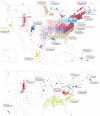Clustering of 770,000 genomes reveals post-colonial population structure of North America
- PMID: 28169989
- PMCID: PMC5309710
- DOI: 10.1038/ncomms14238
Clustering of 770,000 genomes reveals post-colonial population structure of North America
Abstract
Despite strides in characterizing human history from genetic polymorphism data, progress in identifying genetic signatures of recent demography has been limited. Here we identify very recent fine-scale population structure in North America from a network of over 500 million genetic (identity-by-descent, IBD) connections among 770,000 genotyped individuals of US origin. We detect densely connected clusters within the network and annotate these clusters using a database of over 20 million genealogical records. Recent population patterns captured by IBD clustering include immigrants such as Scandinavians and French Canadians; groups with continental admixture such as Puerto Ricans; settlers such as the Amish and Appalachians who experienced geographic or cultural isolation; and broad historical trends, including reduced north-south gene flow. Our results yield a detailed historical portrait of North America after European settlement and support substantial genetic heterogeneity in the United States beyond that uncovered by previous studies.
Conflict of interest statement
The authors declare competing financial interests: authors affiliated with AncestryDNA may have equity in Ancestry; T.R. and S.S. were summer interns at Ancestry when they contributed to this work; E.B. received consultant fees from Ancestry; and a provisional patent application has been filed relating to this work (Application #15/168,011).
Figures






Similar articles
-
Population Histories of the United States Revealed through Fine-Scale Migration and Haplotype Analysis.Am J Hum Genet. 2020 Mar 5;106(3):371-388. doi: 10.1016/j.ajhg.2020.02.002. Am J Hum Genet. 2020. PMID: 32142644 Free PMC article.
-
Reconstructing the population genetic history of the Caribbean.PLoS Genet. 2013 Nov;9(11):e1003925. doi: 10.1371/journal.pgen.1003925. Epub 2013 Nov 14. PLoS Genet. 2013. PMID: 24244192 Free PMC article.
-
Gene flow from North Africa contributes to differential human genetic diversity in southern Europe.Proc Natl Acad Sci U S A. 2013 Jul 16;110(29):11791-6. doi: 10.1073/pnas.1306223110. Epub 2013 Jun 3. Proc Natl Acad Sci U S A. 2013. PMID: 23733930 Free PMC article.
-
Robust Inference of Identity by Descent from Exome-Sequencing Data.Am J Hum Genet. 2016 Nov 3;99(5):1106-1116. doi: 10.1016/j.ajhg.2016.09.011. Epub 2016 Oct 13. Am J Hum Genet. 2016. PMID: 27745837 Free PMC article.
-
Ancestral components of admixed genomes in a Mexican cohort.PLoS Genet. 2011 Dec;7(12):e1002410. doi: 10.1371/journal.pgen.1002410. Epub 2011 Dec 15. PLoS Genet. 2011. PMID: 22194699 Free PMC article.
Cited by
-
A founder mutation in the PLPBP gene in families from Saguenay-Lac-St-Jean region affected by a pyridoxine-dependent epilepsy.JIMD Rep. 2021 Feb 23;59(1):32-41. doi: 10.1002/jmd2.12196. eCollection 2021 May. JIMD Rep. 2021. PMID: 33977028 Free PMC article.
-
Attacks on genetic privacy via uploads to genealogical databases.Elife. 2020 Jan 7;9:e51810. doi: 10.7554/eLife.51810. Elife. 2020. PMID: 31908268 Free PMC article.
-
Native American gene flow into Polynesia predating Easter Island settlement.Nature. 2020 Jul;583(7817):572-577. doi: 10.1038/s41586-020-2487-2. Epub 2020 Jul 8. Nature. 2020. PMID: 32641827 Free PMC article.
-
Revealing the recent demographic history of Europe via haplotype sharing in the UK Biobank.Proc Natl Acad Sci U S A. 2022 Jun 21;119(25):e2119281119. doi: 10.1073/pnas.2119281119. Epub 2022 Jun 13. Proc Natl Acad Sci U S A. 2022. PMID: 35696575 Free PMC article.
-
Population Histories of the United States Revealed through Fine-Scale Migration and Haplotype Analysis.Am J Hum Genet. 2020 Mar 5;106(3):371-388. doi: 10.1016/j.ajhg.2020.02.002. Am J Hum Genet. 2020. PMID: 32142644 Free PMC article.
References
Publication types
MeSH terms
LinkOut - more resources
Full Text Sources
Other Literature Sources

